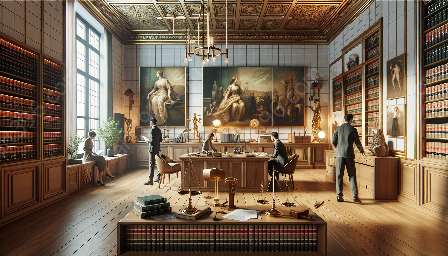Art installations and public art are powerful mediums for artistic expression, often raising complex legal questions related to intellectual property rights in art and art law.
Understanding the Legal Landscape
Art installations and public art are subject to a multitude of legal considerations, encompassing intellectual property rights, contracts, and public or municipal regulations. When addressing the legal aspects of these artistic forms, a comprehensive understanding of the intellectual property framework and art-specific laws is essential.
Intellectual Property Rights in Art
Intellectual property rights play a crucial role in art installations and public art. Artists maintain copyright protection for their original works, including installations and murals, under existing intellectual property laws. However, issues pertaining to the copyrightability of temporary installations and the rights of artists in public spaces are areas of ongoing legal debate.
Moreover, the intersection of trademark law with public art installations further complicates the legal landscape. Artists and sponsors must carefully navigate issues related to the use of trademarks in conjunction with public art, ensuring compliance with relevant laws and regulations.
Art Law
The field of art law encompasses a wide range of legal aspects related to the creation, exhibition, and sale of art. From contractual agreements to disputes over ownership and authenticity, art law serves as a critical framework for resolving legal issues that arise in the art world.
When applied to art installations and public art, art law guides the negotiation and execution of contracts between artists, sponsors, and venue owners. Adhering to art-specific legal principles ensures that all parties involved are protected and that the artistic vision is preserved throughout the installation process and beyond.
Navigating Legal Challenges
As artists and sponsors conceptualize and execute art installations and public art, they must proactively address various legal challenges. This includes obtaining necessary permits, safeguarding intellectual property rights, and negotiating clear contracts to delineate responsibilities and rights.
Furthermore, public art often involves engaging with local regulations, community stakeholders, and municipal bodies. Understanding the legal implications of displaying art in public spaces is paramount to mitigating potential conflicts and ensuring compliance with relevant laws.
Protecting Artistic Integrity
Amidst legal considerations, preserving the artistic integrity of installations and public art remains a central concern. Negotiating legal parameters while upholding the artistic vision demands close collaboration between legal experts and artists to find a balance between legal compliance and creative expression.
Conclusion
Art installations and public art emerge as complex intersections of artistic expression and legal regulation. Navigating the legal aspects of these forms requires a nuanced understanding of intellectual property rights in art, art law, and the practical constraints of exhibiting art in public spaces. By addressing these legal considerations thoughtfully, artists, sponsors, and stakeholders can ensure the successful realization of compelling and legally sound art installations and public art displays.

